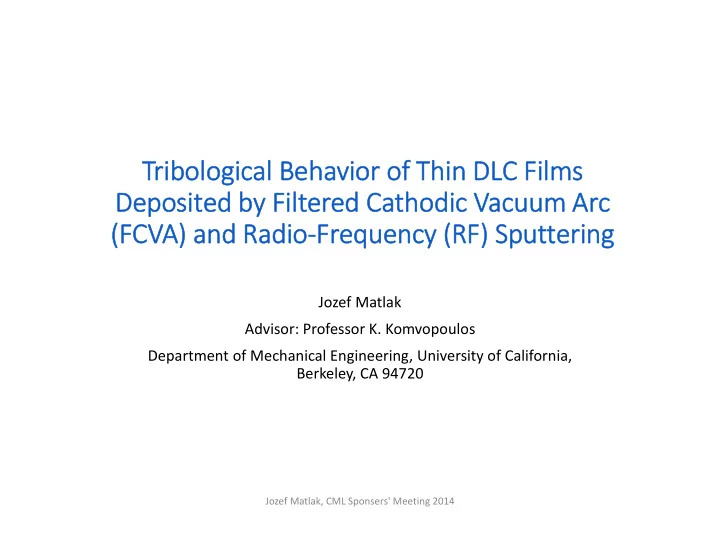

Tribologic ibological al Beha Behavior vior of of Thin Thin DL DLC Film Films Deposi Deposited ted by by Fi Filter ered ed Ca Cathodic thodic Vacuum cuum Ar Arc (F (FCV CVA) A) and and Radio Radio ‐ Fr Frequency equency (RF) (RF) Sput Sputtering ring Jozef Matlak Advisor: Professor K. Komvopoulos Department of Mechanical Engineering, University of California, Berkeley, CA 94720 Jozef Matlak, CML Sponsers' Meeting 2014
In Intr troductio oduction • Objectives ‒ Compare the friction characteristics of thin diamond ‐ like (DLC) overcoats synthesized under optimum deposition parameters using: ‒ Filtered Cathodic Vacuum Arc (FCVA) ‒ Radio Frequency (RF) Sputtering ‒ Investigate the dominant frictional mechanisms for each type of overcoat Jozef Matlak, CML Sponsers' Meeting 2014
Deposition Deposition met method od ‐ Fi Filter ered ed Ca Cathodi thodic Va Vacuum Ar Arc (F (FCVA) Energetic C + ions are produced from vacuum arc discharges • between a graphite cathode and a grounded anode FRONT VIEW The energetic C + ions travel through a curved duct that has • a focusing magnetic field and a steering field for filtering out any macroparticles ejected from the cathode Key parameters : • Bias voltage controls the C + ion energy • Incident angle controls the thickness of the film • and the intermixing as well as the film surface roughness Deposition time controls the film thickness • Substrate bias � Anode Substrate TOP VIEW Jozef Matlak, CML Sponsers' Meeting 2014
Deposition Deposition met method od ‐ Radi Radio Fr Frequency equency Sput Sputteri ring ng • Carbon material is sputtered off from a high ‐ purity graphite target by bombarding Ar + ions • Energetic Ar + ion bombardment enhances the film density and hardness by re ‐ sputtering the weakly bonded carbon atoms during film deposition • The intensity of Ar + ion bombardment depends on the substrate bias voltage (0 to ‐ 300V) Target Gas Vacuum Carbon Feed Pump Ar+ Substrate Jozef Matlak, CML Sponsers' Meeting 2014
In Investig igated ed Film Films • Comparison of the friction characteristics of DLC films (5 to 35 nm thickness) deposited on Si(100) by FCVA and RF sputtering under optimum deposition conditions conducive to the formation of high hardness (high sp 3 content) ultrathin DLC overcoats • Samples FCVA: Thickness (nm) Incident Angle Bias (V) Deposition Time (s) 5 20° ‐ 100 30 10 10° ‐ 100 12 20 45° ‐ 100 30 35 90° ‐ 100 30 RF: Thickness (nm) Power (W) Bias (V) Deposition Time (s) 5 750 ‐ 200 30 10 750 ‐ 200 60 20 750 ‐ 200 120 35 750 ‐ 200 210 Jozef Matlak, CML Sponsers' Meeting 2014
FC FCVA vs. vs. RF RF ‐ Film Film Thi Thickness kness Ef Effect on on Friction Friction Beha Behavi vior or FCVA ‐ films RF ‐ films Instrument: Hysitron Triboscope Diamond tip: R = 1 µm Jozef Matlak, CML Sponsers' Meeting 2014
FC FCVA vs. vs. RF RF ‐ Film Film Thi Thickness kness Ef Effect on on St Steady eady ‐ St State CO COF • RF sputtered films demonstrate notably lower COF under the same scratching conditions. • Most films (except 5 ‐ 7 nm) demonstrate a decrease and then an increase in COF with the increase of the load. Jozef Matlak, CML Sponsers' Meeting 2014
FC FCVA vs. vs. RF RF ‐ Film Film Thi Thickness kness Ef Effect on on Film Film Roughness ughness FCVA ‐ deposited film RF ‐ deposited film ~5 nm 10 nm 20 nm 35 nm • Film surface roughness was determined from 5 µm x 5 µm surface area AFM images. • Roughness trends generally correlate with those of the steady ‐ state COF. Jozef Matlak, CML Sponsers' Meeting 2014
Di Discussion scussion • Important factors affecting friction ‒ sp 2 / sp 3 content Increase in sp 2 may yield lower friction due to the predominantly graphitic structure of the film ‒ Penetration depth The soft graphitic layer, however, can enhance plowing of the material, thereby increasing COF ‒ Load/Substrate effect Substrate elasticity and normal load affect tip penetration and, in turn, the COF • Friction mechanisms ‒ sp 3 ‐ rich FCVA ‐ deposited films, once penetrated, show higher friction than RF sputtered films even though the penetration depth is less than that in RF films under the same load; thus, shear resistance may be greater for FCVA films. ‒ Because the substrate is more compliant than the film, the contact area increases, leading to the increase of the COF at higher loads. Jozef Matlak, CML Sponsers' Meeting 2014
Conclusions Conclusions • Despite the lower overall roughness, FCVA ‐ synthesized DLC films exhibit higher friction than RF sputtered films for the entire range of normal load and film thickness examined. • Differences in the shear resistance to plastic flow may account for the main differences in friction properties of RF sputtered and FCVA ‐ deposited DLC films. Future Wo Futur Work • Synthesize by FCVA bi ‐ layer DLC overcoats consisting of a ~1 ‐ nm ‐ thick top layer with a high sp 2 content and a 2 ‐ 3 ‐ nm ‐ thick sublayer with a high sp 3 content • Investigate the microstructure of RF sputtered and FCVA ‐ synthesized DLC films to explain frictional mechanisms • Quantify other important nanomechanical/tribological properties, such as scratch hardness and wear resistance of single and bi ‐ layer DLC overcoats. Jozef Matlak, CML Sponsers' Meeting 2014
Thank you! ank you! Questions? Jozef Matlak, CML Sponsers' Meeting 2014
Recommend
More recommend